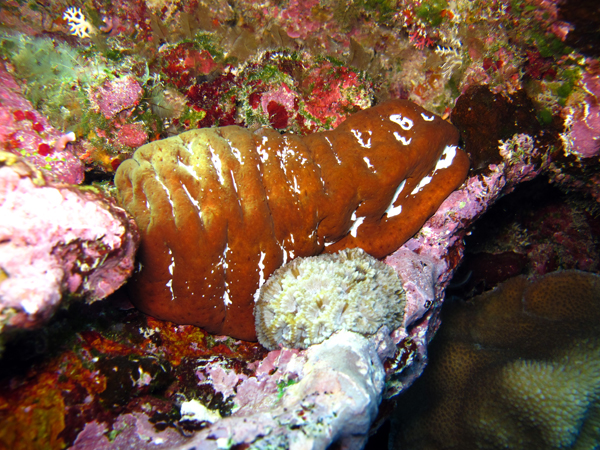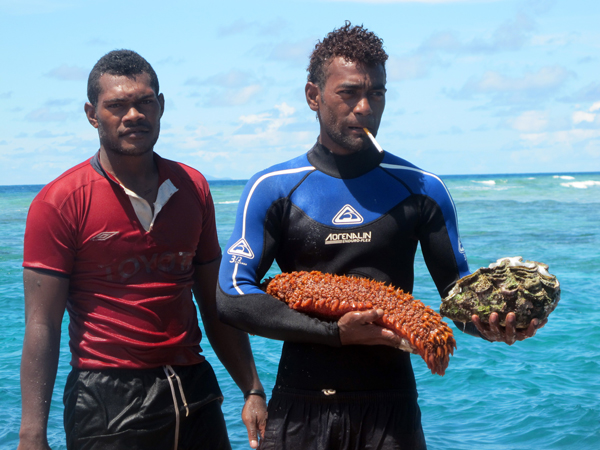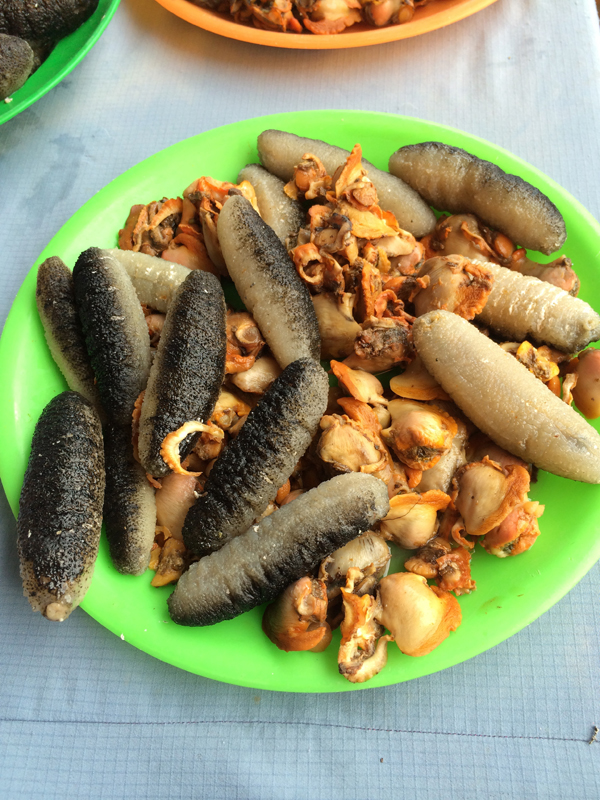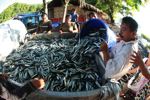What’s it Worth? Deepening pressure on Fiji’s coral protectors.
Redfish, Greenfish, Blackfish.
Pinkfish, Curryfish, Lollyfish.
They sound like Dr. Seuss characters and certainly look like they should be. Yet these sausage-shaped, rubbery animals stippled in fleshy bumps are not fish at all, but an invertebrate in the group that includes sea stars, sea urchins and sand dollars. Sea cucumbers, referred to as “bêche-de-mer” or “trepang” when sold as dried food, are largely motionless creatures, which is why divers scoop hundreds of them up daily to export to Asia. A single high value individual in Fiji can fetch about $80 US, notes one report.
Sea cucumbers are not a new food craze; the Chinese have eaten them at least since the 1600s and sought this delicacy from Fiji since the early 1800s. Today, the increasing market demand and the push to dive deeper for these invertebrates and start new fisheries in other countries have sent stocks declining worldwide. Some have disappeared locally in Pacific Island nations, and in Fiji, divers are actually dying for them.

A surf redfish, a high-valued sea cucumber, wedged into reef crevices near Mago Island in Fiji’s Lau group. Photo courtesy of Stacy Jupiter
Sea cucumbers are often found just offshore, in sea grass beds, on the sandy seafloor, or wedged within reefs. Their slow nature and proximity to shore encouraged an easy harvest, particularly without a specific management plan or an enforced licensing system in Fiji. They’ve been taken before they can mature, or thinned to such low densities that detecting the chemical cues to spawn may not occur, making reproduction and recovery unlikely in many areas. Pacific island countries such as Samoa that declared a moratorium on bêche-de-mer exports have seen no recovery for some species. In fact, moratoriums in other countries have placed the burden on Fiji, which harvests 27 sea cucumber species and has seen an increase in export companies. Remote areas or deeper waters, where species such as amberfish or tigerfish would be naturally protected by depth, are now also targets. To reach them, fishermen deploy sea cucumber bombs (heavy lines with hooks). They have also increased their use of underwater breathing apparatus (UBA), which is normally banned, but is used illegally or exempted in many cases by the Fijian government.
To meet the costs of dive gear that is often lent by middlemen and the pressure of quotas, the harvesters may extend their time underwater, disregarding dive protocol, which can lead to death or paralysis from decompression sickness. The Fiji Times reported in April of 2013, “over the past eight years, 18 villagers from Naviti died from the use of UBAs while more than 12 developed partial paralysis.” Household interviews conducted on some of Fiji’s islands also confirmed deaths and injuries from SCUBA diving for bêche-de-mer. Numerous local newspaper articles document this problem, and it’s likely many more accidents go unreported, particularly in the outer islands.

Divers harvesting live sea cucumbers, like this prickly redfish, which IUCN classifies as Endangered, will sometimes bring up other species such as this giant clam. Photo by Stacy Jupiter
The Indo-Pacific region overall has experienced enormous fishing pressure, with more than half of the region’s sea cucumber stocks depleted or over-harvested, according to a study published online in 2011. In fact, of the 1,200 species worldwide, 16 in the order Aspidochirotida are at risk of extinction and listed on the International Union for Conservation of Nature (IUCN) Red List as either “Vulnerable” or “Endangered.” Nine of those are found in Fiji.
It’s not surprising to most locals or scientists that several sea cucumber populations are going by the wayside. Indigenous knowledge combined with abundance surveys led by organizations such as Wildlife Conservation Society (WCS) and Secretariat of the Pacific Community (SPC) reach similar conclusions for Fiji’s stock: density has markedly decreased well below a point considered healthy, export bans are often ignored, exemptions for the use of SCUBA have increased, and the only size limit placed on all sea cucumbers (3 inches) is not biologically relevant. Locally protected areas showed a slightly brighter picture for some species, but overall numbers are so low or nonexistent that declaring average sizes or trends would be inaccurate.
WCS also observed that the prices in the sea cucumber fishery can be all over the board, and often communities are not fairly compensated. In some instances, however, income from this industry can extend beyond what the communities needs. In one case FJ$24,000 ($13,200) went to the church. In another, income went to build a second house in Suva. Trade in Fiji has expanded and crashed a few times since the 1830s, but recent surveys appear to show no single species completely missing yet from Fiji. Nonetheless, a few, such as black teatfish, golden sandfish, and white teatfish, have already disappeared from local regions around Fiji.

Laying out the catch for processing sea cucumbers on Yadua Island in Fiji. Photo courtesy of Stacy Jupiter
Export of the sandfish (Holothuria scabra) has been banned since 1988, but “unfortunately, it’s still being exported (illegally) and regulators still aren’t doing much to control this,” Margaret Fox of WCS writes in an email. The ban may have been intended as a safeguard for subsistence use only, but Fiji’s outdated Fisheries Act does not state they can’t be sold locally within the size limit. SPC reports this highly prized sandfish, listed as endangered by IUCN actually shows up on export lists required by customs. In a market study done in Hong Kong, one store was found selling large sandfish for US$1668/kg ($758/pound).
Scientists have continuously called for enacting a national management plan, enforcing legal size limits, moratoriums, and better tracking of harvests, as well as ending exemptions to UBA use. Without a major shift in policy for sea cucumbers, many stocks may be headed for collapse. Biological traits are not always known for every species, and each has different ecological needs, so using a one-size-fits-all management approach won’t work. Normally, size and geographic restrictions can help push a species into extinction, but in this case high market value for bêche-de-mer is partly responsible. Rarity hikes the price tag. Bluefin tuna, both highly-valued and endangered, is a classic example.
Yet, the situation is complicated. The extended family dynamics of Fijians can create challenges when enforcing laws. More importantly, bêche-de-mer is a significant cash source for those in remote areas with limited moneymaking options. A recent project helping fishers process sea cucumbers to a higher standard found this fishery employed 5,000 to 7,000 Fijians. Fiji also has strong economic relations with China after opening the door to China’s business following Fiji’s coups.
Breaking it Down
Why should we care about these “unglamorous invertebrates?” Aside from providing a curious delight to divers when they defensively spew out a mess of spaghetti strings from their digestive system through their anus, these echinoderms can effectively shape the habitat for ocean floor residents. They act like mini turbines to break up the ocean bottom, serve as food for other species, clean up the seabed for sea grass to thrive, and break down organic matter so nutrient-loving algae don’t take over. When they rifle through the sand ingesting feces, nutrients, and other detritus, much like worms burrowing through compost, cleaned sediment and calcium carbonate shoot out their rear end- forming the basis for coral reefs. Furthermore, a recent study on the Great Barrier reef revealed more alkaline waters surrounding two species of sea cucumbers. This invertebrate’s ability to increase pH could balance the effects of ocean acidification. So the issue is not just about losing species. Without them we may lose a local, natural buffer against the breakdown of coral reefs, altering both the geochemistry and biology of the reef.

Sea cucumbers, such as this highly valuable white teatfish (Holothuria fuscogilva), can be semi-or fully processed in the village, which initially involves removing the guts and outer skin. Most are exported as a dried product. Photo courtesy of Stacy Jupiter
Dr. Christopher Mah, an echinoderm expert at the Smithsonian National Museum of Natural History, notes we are still learning about their biology. These “innocuous turd-shaped echinoderms” were the subject of research three years ago pinpointing their role in marine systems, he says. Considering the amount of time humans have been harvesting sea cucumbers, the fact that we “only just now know how important they are, speaks volumes to our ignorance,” says Mah.
Such ignorance is why a management plan couldn’t come sooner. It’s not uncommon for humans to harvest creatures from the ocean before knowing enough about their biology or feeding or mating habits (e.g. bluefin tuna, white sharks). If demand is there, the market doesn’t usually wait for science to catch up. And Asia, particularly China, has been demanding sea cucumbers for years. China wiped out most of its local stock of Apostichopus japonicas, and now raises them through aquaculture, although that effort has apparently not dented market prices. This delicacy can be consumed in all forms: raw, dried, cooked, and in traditional remedies for cancer and arthritis that one can buy off eBay.
Village Views
A visit to the seaside village of Silana, situated in a pine forest mixed with palm trees in the northern part of Viti Levu, meant bumping along on a bus down a gravelly road for a few hours to get there. Silana once had a booming sea cucumber business, mostly for the valuable white teatfish, when it was not unheard of to bring in FJ$9,000 ($4,900) worth overnight. Silana wasn’t terribly far from Suva, but a cyclone had recently broken apart the new road, and it felt very isolated.
Around the kava bowl, the village herald Meli Rabele and another resident told stories of their experiences diving for bêche-de-mer. In the late 1990s they could gather sea cucumbers just offshore. In 2010, middlemen from Soluk Enterprises came into Silana and changed that. The really nice white ones could fetch FJ$110 (~$55), says Rabele. “But we took home only a quarter of that.”

Fishermen in fiberglass boats pull up to an ideal landing along the Suva waterfront to unload sea cucumbers. Onlookers watch while buyers note weights and prices beneath an umbrella. Photo by Amy West
It was “easy money,” they say, joking about being able to hit the nightclubs in Suva. It was lucrative enough that some families actually owned their own dive gear and tanks. In 2010, the Department of Fisheries busted their group of 20 divers. Their license had actually expired, though a license costs mere pennies compared to the sea cucumber revenue. Fisheries confiscated the catch and gear, but Soluk surprisingly still paid the divers. The divers wondered if Soluk bought the confiscated goods later, because “in two weeks we were normal again,” says Rabele—their license renewed and dive gear returned. They had to harvest the sea cucumbers farther and farther from shore, up to an hour away. The middlemen stopped coming a few years later when profits dwindled away, but the men weren’t upset about their fishery vanishing. In fact, they regurgitated facts about the sea cucumber’s ecological role as if they had been told a million times. Their attitude was to simply not stress about it and switch to another fishery, or return to the plantation. Keep on a normal tack. After all, did they need that much money for a subsistence lifestyle?
The village of Waitabu on Fiji’s third largest island, Taveuni, sits next to Waitabu Marine Park, where protection from fishing began in 1998. The sea cucumber trade was non-existent there at the time. The community said no to harvesting sea cucumbers in both their protected area and their entire fishing grounds when they were approached four years ago, because they understood the ecological value of sea cucumbers. Their protection work paid off, but the area caught the attention of poachers.
“They shouldn’t be conserving this for the profit of other people,” says Helen Sykes, director of Marine Ecology Consulting, who’s been helping Waitabu to manage their fishery resources. As a test, they opted for a sustainable and empirical approach by establishing a temporary protected zone adjacent to the permanent one, where they could eventually have controlled sea cucumbers harvests.
Yes, raising awareness is important, says Sykes, and Fijians do understand why not to take sea cucumbers off the reef. “But at the end of the day a dollar is a dollar,” she says, “and it’s a very exceptional community that will say no to a dollar.” Sykes, who’s worked with Fijian communities since 1998, believes knowing the consequences is not enough; providing other options to make money also has to be part of the solution.
Wharf Deals
 An early morning sale of sea cucumbers along the sea wall in Suva show some species still in buckets: brown sandfish, chalkfish, tigerfish, pinkfish, and in the center, the very valuable and often hard to find, white teatfish. Photo by Amy West |
An Asian restaurant owner in Suva (who wished not to be named), pointed me toward a convenient spot along Suva’s waterfront where I would find fisherman arriving with buckets of sea cucumbers every morning from 6 a.m. He explained that a Chinese-owned seafood export business usually bought them to export, and “guards” would most likely be stationed on either side of the buyers. I made my way there about 7:45 a.m. to investigate what was left. The place was a perfect landing for boats to approach and very quickly offload catch directly onto a truck. A few bright orange buckets of slimy curled up cucumbers still lay on the wharf: chalkfish, tigerfish, and the prized white teatfish. A small, black plastic bag lay atop a white tub of sea cucumbers next to the curb ready to be picked up, and a similar bag was passed from the boat to a guy sitting on the sea wall. He briefly opened the bag up, and then closed it. The fisherman told me it was a wetsuit, which didn’t appear to be the case. I wondered if it contained other marine animals that are often captured during sea cucumber harvests. The whole scenario felt almost clandestine.
When I ask where they got all these sea cucumbers, one man, perhaps the guard, says, “All over! All over!” “And where do they go? I ask. “We sell them to restaurants,” he replies, perhaps misunderstanding me, because the lady next to him, holding a notebook and calculator and recording the catch, immediately replies that they export the sea cucumbers. When I ask who the buyer was, I didn’t get a specific answer, only a gesture and the words “Laucala Beach.” I remembered the restaurant owner had told me the exporter had a small seafood retail shop at Laucala Beach near Centrepoint Mall, where he himself had occasionally found the banned humphead wrasse. Gold Hold actually runs this seafood store, whose Chinese owner is the brother of the owner of Golden Ocean, one of the leading tuna export companies in Fiji.
A visit to Suva’s Saturday market revealed juvenile, finger-long sandfish on plates with mussel meat, and also the vulnerable and expensive white teatfish. WCS’s Margaret Fox, who helped to identify the species, was surprised to learn white teatfish were sold in the local market, but explained they were sold to the local Chinese for FJ$60-$120 ($33-66) a pile and usually opportunistic. Sea cucumbers are not an overly common food item for Fijians. Sandfish can be caught for subsistence; however, selling them at a market is not defined as subsistence use.
Later that afternoon when sitting with Sanaila Naqali, Deputy Secretary of Fisheries and Forests, and Suresh Chand, the Director of Fisheries, I ask them why they weren’t doing more to monitor sea cucumber catches when fisherman came to shore. Had they been down to the wharf and checked out the morning trade?
“Their intel network is very good,” Naqali explains. The traders can send out texts and messages if they know we are around, he says, so when Fisheries or the Navy arrives there’s nothing to search!

In recent times Suva’s fish market is fairly quiet during the week, though that was not always the case. During a busy Saturday morning, aside from sea cucumbers, one can also find crabs and reef fish. Photo by Amy West
Of course, Naqali and Chand were well aware of the sea cucumber sales along the seawall; they just felt grossly under-resourced. “We have no specific wing for control and surveillance,” says Chand. He notes they do periodic sweeps of the Saturday market and accompany the police and Navy on patrols, though Fisheries’ boats are “open punts” Naqali says, and not fit for patrols. Chand indicated surveillance might occur at least 20 times a year. In addition, they train fish wardens in the villages, who are not paid and generally without resources, to be extra eyes on the water since Fiji’s fishing grounds are scattered over an enormous distance.
“We’d like to plug our gaps, says Naqali, “more money, people, infrastructure.”
Whether surveillance was opportunistic or an official part of the Fisheries department as indicated on their website, there was no question of its ineffectiveness. No one disagreed that Fiji’s Fisheries department was underfunded and understaffed, but as Margaret Vakalalabure, a Fisheries research officer, pointed out, the first core role of Ministry of Fisheries and Forests “unfortunately is fisheries development,” which includes finding markets for fishermen, setting up ice plants, or providing gear for fishing. They are currently trying to balance that with conservation and fisheries management.
Altering mindsets
What would happen if sea cucumbers disappeared from the reefs? Nature is resilient, says Mah, but it depends on how you want your coral reef to function. “Do you want diversity, or do you want a monoculture with algae and some polychaetes (marine worms)?” Without multiple species each playing a role, a reef ecosystem is vulnerable to disease or environmental change.

Sea cucumbers move at a snail’s pace and feed by extruding sticky tube feet, much like their sea star cousins. Photo courtesy of Stacy Jupiter
Though some exported sea cucumber species have been misidentified, and inspections verifying their length and weights are rare, recent data on their export price have finally helped illustrate the true economic value of Fiji’s bêche-de-mer. The study’s author, Steven Purcell of Southern Cross University, writes that based on export volumes and conversions of dried product to fresh animals, “several million sea cucumbers are harvested from Fiji reef habitats each year.” SPC calculated their weight in exports to be just under half that of tuna from 2003 to 2008, and probably brought in roughly 10 million FJD annually. In other words, sea cucumber is valuable.
Which is why Fijians, even 16-year old boys, risk their lives for it. The desire to have luxurious items such as cars, and iPods and mobile phones is certainly a driver. Etika Rupeni, a coordinator in ecosystem management at IUCN, believes the key is engaging the fishermen, and meeting them where they land their catch, for example, at the sea wall.
“That’s where we should be doing the enforcement. We don’t have the funds to run around in fancy boats.” Rupeni emphasized the need to treat it as an awareness campaign and make “these fisherman part of our team trying to protect fisheries, so that they care about the fisheries,” he says. “Because if it’s your livelihood, you should care about it.”
It’s not clear what needs to occur first to keep people from dying for these valuable invertebrates; perhaps when the demand for these creatures lessens. After much pressure worldwide, the Chinese government took steps to ban shark fin soup at least from its official banquets. Sea cucumbers may not have the same public appeal as sharks, but without a strong management plan for wild stock exported to Asia, some might just naturally fall off the menu.
 Piles of undersized sandfish, which are banned from being exported, sit atop mussels in Suva’s Saturday market. Photo by Amy West
Piles of undersized sandfish, which are banned from being exported, sit atop mussels in Suva’s Saturday market. Photo by Amy West
}}
Related articles
Former Miss South Pacific steps into new conservation role

(05/15/2014) Alisi Rabukawaqa, an articulate, vibrant, 26-year-old Fijian known in Oceania as Miss South Pacific 2011, has set her sights on a novel conservation program in Fiji. The Conservation Officer program, created in 2013, supports natural resource management within villages in Fiji and links them with the government arm overseeing the needs of indigenous Fijians. Mongabay.org Special Reporting Initiative Fellow Amy West sits down for an interview.
Two journalists awarded prizes for reporting on fisheries in the Pacific

(01/20/2014) Mongabay.org – a non-profit dedicated to raising awareness of social and environmental issues relating to tropical forests and other ecosystems – has announced the winners of two environmental reporting prizes under its Special Reporting Initiative (SRI) program. The prizes sought proposals to investigate questions around marine fisheries management in the Pacific.
Protected forests linked to healthy coral reefs in Fiji

(01/27/2014) Increasing forest protection in the right areas could increase benefits up to 10.4 percent to coral reef condition, according to a recent study of Fiji’s forests and reefs in Marine Policy. Benefits from protected forests such as improved water quality due to decreased runoff and increased distribution of the vegetation are more closely linked to coral reef health than previously thought.
98% of marine fish headed for the aquarium trade die within a year in the Philippines

(10/22/2013) Almost all wild caught marine fish for the aquarium trade will die within a year of capture, according to WWF. Following months of interviews with Filipino marine exporters and hobbyists, WWF-Philippines have found that roughly 80% of all marine fish die before they are sold, and those that survive long enough to be bought by hobbyists are extremely likely to be dead in under a year.